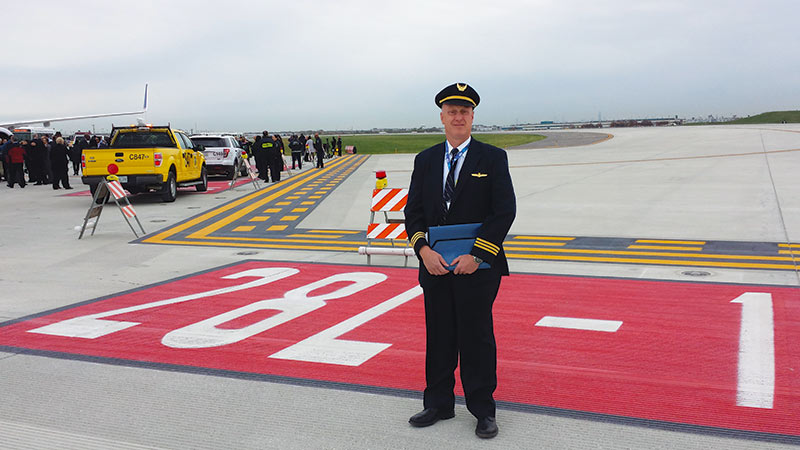Five Questions For ALPA’s Airport & Ground Environment Group Chair
Powered by Pilots
By Christopher Freeze, Senior Aviation Technical Writer

Capt. Jeff Sedin (United) leads ALPA’s airport and ground environment advocacy efforts.
Editor’s note: This column showcases the efforts of a cross section of ALPA pilots who volunteer their time and talents to advocate for the union’s priorities and the cadre of knowledgeable and passionate staff specialists who support them.
The Airport & Ground Environment (AGE) Group, a component of ALPA’s Air Safety Organization (ASO), builds cooperative relationships with airport authorities, the FAA, and Transport Canada to share line-pilot concerns unique to specific airports, promote airport certification requirements, and improve the understanding of airport operator challenges.
Air Line Pilot sat down with Capt. Jeff Sedin (United), the AGE Group chair, to learn more about the pilot who leads the ASO’s airport and ground environment advocacy efforts.
Air Line Pilot:
1. How did you get into aviation/flying?
Capt. Jeff Sedin: I grew up on the north side of Chicago, on about an eight-mile final to the current Runway 27L, where I watched planes land and take off. When I was 13 years old, my grandparents gave me and my cousin a Christmas present of a sightseeing flight out of Meigs Field. I was hooked! For my next birthday, my parents signed me up for a ground school class and a flight.
I attended the University of Illinois and earned my pilot and instructor ratings, airframe and powerplant mechanic certificates, and a degree in business administration. After graduating, I worked at Eglin Air Force Base as an instructor at the aero club and then flew light twins along the Gulf Coast. In 1988, I was hired by Simmons Airlines and flew the Shorts 360 and ATR 42/72s. United Airlines hired me in 1997, and I’ve flown numerous aircraft over the years. I’m currently a B-737 line check airman based at Chicago O’Hare International Airport.
2. How did you first become involved with ALPA work?
Sedin: My first flight instructor in college was the secretary-treasurer for the Simmons Master Executive Council (MEC). When I was hired by the airline, he asked if I wanted to get involved with accident investigation, knowing I had taken related courses in college. Figuring I should become more involved, the position interested me. In 1990, I met Capt. Mack Moore, a former AGE chair, and he asked me to be an ALPA airport safety liaison (ASL) for O’Hare and I accepted. I attended meetings, listened, and reported to him anything that didn’t seem correct from a pilot’s perspective. I slowly learned from the various people and organizations at O’Hare that help to make the airport function efficiently.
3. What are your roles and responsibilities as the AGE Group chair?
Sedin: My main responsibility is to keep airports safe for pilots and the passengers and cargo we transport. Most airport operators have the best intentions, but they may not realize that what makes sense to the people at one airport could be confusing and dangerous to pilots who fly into multiple airports, often on the same day.
ALPA’s ASLs are the backbone of the AGE Group. They engage with airports to correct safety issues and prevent unsafe practices by providing the line pilot’s perspective. Given the vast experience of ASLs and the input they provide me, I’m able to work effectively on various FAA and industry groups. At the national and international level, I speak for pilots on issues that affect us at airports.
4. How do you see ALPA national and staff helping you achieve your goals?
Sedin: I couldn’t do my job without the support of ALPA staff, especially staff from the Engineering & Air Safety Department. They’re the initial point of contact for pilots and organizations seeking assistance with safety-related issues, and they help coordinate and support meetings.
ALPA had been asking the FAA to install precision approach path indicator (PAPIs) on Runway 9L/27R at O’Hare for years, and the FAA’s response was “no” due to budget constraints. We elevated the request with a draft letter to the FAA consisting of approximately 50 words saying that we needed the lights. ALPA staff took that draft and turned it into a six-page letter with graphs, photographs, and an explanation of why the lights are an important safety enhancement. The PAPIs were approved a few months later.
5. What advice would you give to new pilots who want to get involved with ALPA?
Sedin: Find an area that you’re passionate about and volunteer. Even if you commute, there are positions that don’t require you to be in a domicile. Volunteering a few hours per month can make a difference in the quality of life and safety of your fellow pilots. The AGE Group, along with other ASO entities, has lost volunteers due to retirements over the last few years and new members are needed, including ASLs at many airports throughout the U.S. and Canada, so consider volunteering.

